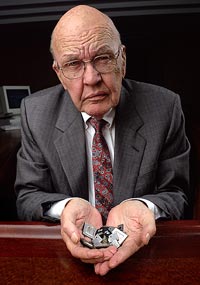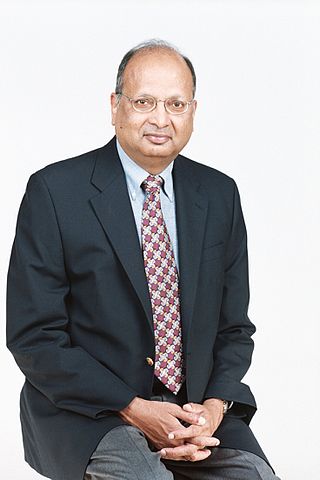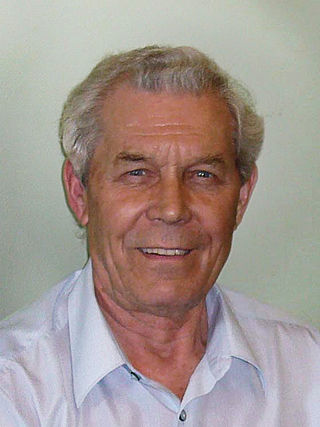
Sir Charles Kao Kuen was a Chinese physicist and Nobel laureate who contributed to the development and use of fibre optics in telecommunications. In the 1960s, Kao created various methods to combine glass fibres with lasers in order to transmit digital data, which laid the groundwork for the evolution of the Internet and the eventual creation of the World Wide Web.

Jack St. Clair Kilby was an American electrical engineer who took part, along with Robert Noyce of Fairchild Semiconductor, in the realization of the first integrated circuit while working at Texas Instruments (TI) in 1958. He was awarded the Nobel Prize in Physics on 10 December 2000.

John Robinson Pierce, was an American engineer and author. He did extensive work concerning radio communication, microwave technology, computer music, psychoacoustics, and science fiction. Additionally to his professional career he wrote science fiction for many years using the names John Pierce, John R. Pierce, and J. J. Coupling. Born in Des Moines, Iowa, he earned his PhD from Caltech, and died in Sunnyvale, California, from complications of Parkinson's Disease.

Paul Beattie MacCready Jr. was an American aeronautical engineer. He was the founder of AeroVironment and the designer of the human-powered aircraft that won the first Kremer prize. He devoted his life to developing more efficient transportation vehicles that could "do more with less".

Scotch Plains-Fanwood High School is a comprehensive regional four-year public high school in Union County, in the U.S. state of New Jersey, which serves students in ninth through twelfth grades from the Township of Scotch Plains and the Borough of Fanwood, operating as the lone secondary school of the Scotch Plains-Fanwood Regional School District. The school has been accredited by the Middle States Association of Colleges and Schools Commission on Elementary and Secondary Schools since 1932.
Alfred Yi Cho is a Chinese-American electrical engineer, inventor, and optical engineer. He is the Adjunct Vice President of Semiconductor Research at Alcatel-Lucent's Bell Labs. He is known as the "father of molecular beam epitaxy"; a technique he developed at that facility in the late 1960s. He is also the co-inventor, with Federico Capasso of quantum cascade lasers at Bell Labs in 1994.
Stanley Donald Stookey was an American inventor. He had 60 patents in his name related to glass and ceramics, some patents solely his and others shared as joint patents with other inventors. His discoveries and inventions have contributed to the development of ceramics, eyeglasses, sunglasses, cookware, defense systems, and electronics.

Arogyaswami J. Paulraj is an Indian-American electrical engineer, academic. He is a Professor Emeritus (Research) in the Department of Electrical Engineering at Stanford University.
Stewart David Personick is an American researcher in telecommunications and computer networking. He worked at Bell Labs, TRW, and Bellcore, researching optical fiber receiver design, propagation in multi-mode optical fibers, time-domain reflectometry, and the end-to-end modeling of fiber-optic communication systems.
Robert D. Maurer is an American industrial physicist noted for his leadership in the invention of optical fiber.
Donald B. Keck is an American research physicist and engineer most noted for his involvement in developing low-loss optical fiber. Keck grew up in Lansing, Michigan and attended Michigan State University, after which he joined Corning Incorporated’s research department. As a senior research scientist for Corning, Keck, along with Robert D. Maurer and Peter C. Schultz, designed the first optical fiber with optical losses low enough for wide use in telecommunications.

Richard H. Frenkiel is an American engineer, known for his significant role in the early development of cellular telephone networks.

Vladimir Polukhin was a Russian scientist and an engineer in the field of optics.

Ching Wan Tang is a Hong Kong–American physical chemist. He was inducted into the National Inventors Hall of Fame in 2018 for inventing OLED, and was awarded the 2011 Wolf Prize in Chemistry. Tang is the IAS Bank of East Asia Professor at the Hong Kong University of Science and Technology and previously served as the Doris Johns Cherry Professor at the University of Rochester.

Paul B. Ruffin is an American scientist and educator. He is active in the field of applied science during his career as a research physicist conducting exploratory and advanced research and development in Fiber-optic communication, Microelectromechanical systems (MEMS), and Nanotechnology at the U. S. Army Aviation and Missile Research, Development, and Engineering Center (AMRDEC). In July 2003, Ruffin was promoted to the highest rank for a research scientist — Senior Research Scientist (ST) — that anyone could achieve in Government service, making him the first African American to ever attain such status in the Civilian Army workforce.

Harold Vincent Poor is the Michael Henry Strater University Professor of Electrical Engineering at Princeton University, where he is also the Interim Dean of the School of Engineering and Applied Science. He is a specialist in wireless telecommunications, signal processing and information theory. He has received many honorary degrees and election to national academies. He was also President of IEEE Information Theory Society (1990). He is on the board of directors of the IEEE Foundation.
Jennie Hwang is a businesswoman, entrepreneur, engineer, scientist, author, and speaker. She is the national president of the Surface Mount Technology Association, head of H-Technologies Group and the first woman to receive a PhD from Case Western Reserve University in Materials Science and Engineering.
Frances S. Ligler is a biochemist and bioengineer who was a 2017 inductee of the National Inventors Hall of Fame. Ligler's research dramatically improved the effectiveness of biosensors while at the same time reducing their size and increasing automation. Her work on biosensors made it easier to detect toxins and pathogens in food, water, or when airborne.
Marshall G. Jones is an American mechanical engineer, inventor, mentor, and teacher. Jones is currently a Coolidge Fellow at General Electric (GE) Global Research. He has been awarded more than 65 U.S. patents and is recognized as a pioneer for laser materials processing and a leading authority on fiber-optic laser beam technology. He is a fellow of the National Academy of Engineering and has been inducted into the National Inventors Hall of Fame.
John Ballato is an American materials scientist, entrepreneur, and academic. He holds the J. E. Sirrine Endowed Chair of Optical Fiber and is a professor of materials science and engineering, electrical and computer engineering, as well as physics and astronomy at Clemson University. He has received many international recognitions for his research on optical and optoelectronic materials, particularly as relates to optical fiber.










